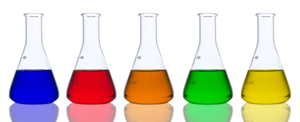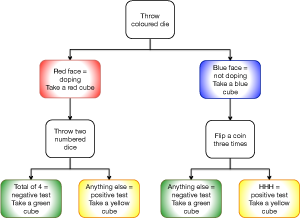Skip over navigation

Or search by topic
Number and algebra
Geometry and measure
Probability and statistics
Working mathematically
Advanced mathematics
For younger learners
Who Is Cheating?
Age 14 to 16
Challenge Level 





- Problem
- Teachers' Resources
This problem is part of the Great Expectations: Probability through Problems collection. It is designed for classroom use; see the Teachers' Resources for a suggested classroom approach.
 A new test is in development to try to identify athletes who use a certain banned substance to enhance their performance.
A new test is in development to try to identify athletes who use a certain banned substance to enhance their performance.
The development team has accumulated data which indicates that although the test shows good results in detecting an athlete who has used this substance, the number of false positives is more worrying.
What are the chances an athlete will be unfairly accused, or will get away with cheating?
You can investigate this question through a practical experiment.
You will need a die with four blue faces and two red faces, two ordinary numbered dice, and some red, blue, green and yellow multi-link cubes. (If you do not have a die with coloured faces, use a numbered die and designate 1, 2, 3 and 4 to be blue and 5, 6 to be red).
 First, investigate what happens for one athlete.
First, investigate what happens for one athlete.
Stick your two cubes together.
What do each of these mean?
Now repeat the experiment 36 times in total, so that you have 36 pairs of cubes.
Are you surprised by your results?
How do they compare with what we would expect?
This worksheet will help you to work out the expected results. You need to be sure that you have correctly identified how many possible outcomes there at each stage, and how many of those give each result - this Sample Space worksheet will help you with that.
Here are some questions to consider:
What can you say about the proportion of false positives (that is, athletes who test positive even though they have not taken the banned substance)?
Given that an athlete is not taking the banned substance, what is the probability that they test positive?
What can you say about the proportion of false negatives (that is, athletes who test negative even though they have taken the banned substance)?
Given that an athlete is taking the banned substance, what is the probability that the test is negative? (What figure should go in the denominator here?)
This worksheet will help you to interpret the expected results as probabilities, leading to a general result for probability trees - the multiplication rule.
For these questions, you will need to identify carefully which set of athletes the question is asking you about, in order to identify which number should go in the denominator - they are not all the same!
Why?
 A new test is in development to try to identify athletes who use a certain banned substance to enhance their performance.
A new test is in development to try to identify athletes who use a certain banned substance to enhance their performance.The development team has accumulated data which indicates that although the test shows good results in detecting an athlete who has used this substance, the number of false positives is more worrying.
What are the chances an athlete will be unfairly accused, or will get away with cheating?
You can investigate this question through a practical experiment.
You will need a die with four blue faces and two red faces, two ordinary numbered dice, and some red, blue, green and yellow multi-link cubes. (If you do not have a die with coloured faces, use a numbered die and designate 1, 2, 3 and 4 to be blue and 5, 6 to be red).
 First, investigate what happens for one athlete.
First, investigate what happens for one athlete.Rules for the simulation:
- Throw the coloured die.
- If it is red, the athlete is taking the banned substance. Take a red cube.
- If it is blue, the athlete is not taking the banned substance. Take a blue cube.
- If the athlete is taking a banned substance , throw two numbered dice.
- If the sum of the two dice is 4 the athlete tests negative - take a green cube.
- Anything else means they test positive - take a yellow cube.
- If the athlete is not taking a banned substance, flip a coin three times.
- Three heads means they test positive - take a yellow cube.
- Anything else means they test negative - take a green cube.
Stick your two cubes together.
What do each of these mean?
- red and yellow
- blue and yellow
- red and green
- blue and green
Now repeat the experiment 36 times in total, so that you have 36 pairs of cubes.
Are you surprised by your results?
How do they compare with what we would expect?
This worksheet will help you to work out the expected results. You need to be sure that you have correctly identified how many possible outcomes there at each stage, and how many of those give each result - this Sample Space worksheet will help you with that.
Here are some questions to consider:
What can you say about the proportion of false positives (that is, athletes who test positive even though they have not taken the banned substance)?
Given that an athlete is not taking the banned substance, what is the probability that they test positive?
What can you say about the proportion of false negatives (that is, athletes who test negative even though they have taken the banned substance)?
Given that an athlete is taking the banned substance, what is the probability that the test is negative? (What figure should go in the denominator here?)
This worksheet will help you to interpret the expected results as probabilities, leading to a general result for probability trees - the multiplication rule.
Extension questions
For these questions, you will need to identify carefully which set of athletes the question is asking you about, in order to identify which number should go in the denominator - they are not all the same!
- What is the probability that an athlete, chosen at random, receives a false positive result?
- Given that an athlete was not taking the banned substance, what is the probability that their test result is positive?
- Given that an athlete receives a positive test, what is the probability that they were not in fact taking the banned substance?
Why?
Rules for the simulation:
- Throw the coloured die.
- If it is red, the athlete is taking the banned substance. Take a red cube.
- If it is blue, the athlete is not taking the banned substance. Take a blue cube.
- If the athlete is taking a banned substance (you have a red cube), throw two numbered dice.
- If the total on the two dice is 4 (ie. 1+3, 3+1, 2+2) that means a negative test result - take a green cube.
- Anything else means a positive test result - take a yellow cube.
- If the athlete is not taking a banned substance (you have a blue cube), flip a coin three times.
- Three heads means a positive test result - take a yellow cube.
- Anything else means a negative test result - take a green cube.
You may also like
The Dog Ate My Homework!
A practical experiment which uses tree diagrams to help students understand the nature of questions in conditional probability.

